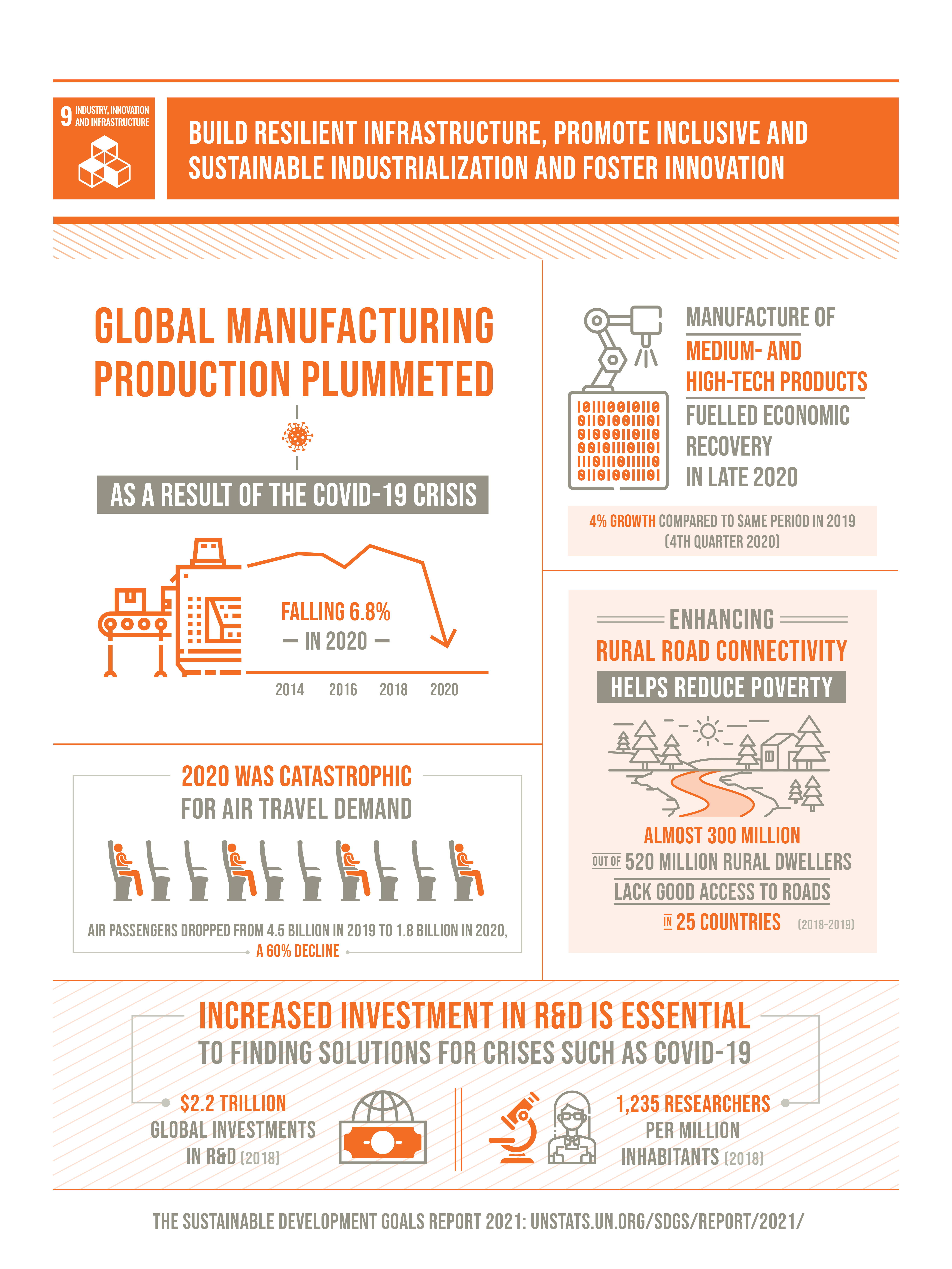



However, the world still has a long way to go to fully tap this potential. Least developed countries, in particular, need to accelerate the development of their manufacturing sector if they are to meet the 2030 target, and scale up investment in scientific research and innovation.
Global manufacturing growth has been steadily declining, even before the outbreak of the COVID-19 pandemic. The pandemic is hitting manufacturing industries hard and causing disruptions in global value chains and the supply of products.
Innovation and technological progress are key to finding lasting solutions to both economic and environmental challenges, such as increased resource and energy-efficiency. Globally, investment in research and development (R&D) as a proportion of GDP increased from 1.5 per cent in 2000 to 1.7 per cent in 2015 and remained almost unchanged in 2017, but was only less than 1 per cent in developing regions.
In terms of communications infrastructure, more than half of the world’s population is now online and almost the entire world population lives in an area covered by a mobile network. It is estimated that in 2019, 96.5 per cent were covered by at least a 2G network.
The coronavirus pandemic has revealed the urgent need for resilient infrastructure. The Asian Development Bank notes that critical infrastructure in the region remains far from adequate in many countries, despite the rapid economic growth and development the region has experienced over the past decade. The Economic and Social Survey of Asia and the Pacific highlights that making infrastructure resilient to disasters and climate change will require an additional investment of $434 billion per year. This sum may need to be even greater in some subregions, such as the Pacific small island developing states.
Facts and Figures:-
- In 2018, 96 per cent of the world’s population lived within reach of a mobile-cellular signal, and 90 per cent of people could access the Internet through a third generation (3G) or higher-quality network.
- 16 per cent of the global population does not have access to mobile broadband networks.
- The global share of manufacturing value added in GDP increased from 15.2per cent in 2005 to 16.3per cent in 2017, driven by the fast growth of manufacturing in Asia.
- Least developed countries have immense potential for industrialization in food and beverages (agro-industry), and textiles and garments, with good prospects for sustained employment generation and higher productivity
- In 2019, the amount of new renewable power capacity added (excluding large hydro) was the highest ever, at 184 gigawatts, 20GW more than in 2018. This included 118GW of new solar systems, and 61GW of wind turbines.
- Capacity investment in solar slipped 3per cent to $131.1 billion in 2019, while that in wind climbed 6per cent to $138.2 billion – the first time that wind has outweighed solar in terms of dollars committed since 2010.
- Developing countries continued to outpace developed economies in renewables investment. In 2019, they committed $152.2 billion, compared to $130 billion for developed countries.
9.1 Develop quality, reliable, sustainable and resilient infrastructure, including regional and transborder infrastructure, to support economic development and human well-being, with a focus on affordable and equitable access for all
9.2 Promote inclusive and sustainable industrialization and, by 2030, significantly raise industry’s share of employment and gross domestic product, in line with national circumstances, and double its share in least developed countries
9.3 Increase the access of small-scale industrial and other enterprises, in particular in developing countries, to financial services, including affordable credit, and their integration into value chains and markets
9.4 By 2030, upgrade infrastructure and retrofit industries to make them sustainable, with increased resource-use efficiency and greater adoption of clean and environmentally sound technologies and industrial processes, with all countries taking action in accordance with their respective capabilities
9.5 Enhance scientific research, upgrade the technological capabilities of industrial sectors in all countries, in particular developing countries, including, by 2030, encouraging innovation and substantially increasing the number of research and development workers per 1 million people and public and private research and development spending
9.A Facilitate sustainable and resilient infrastructure development in developing countries through enhanced financial, technological and technical support to African countries, least developed countries, landlocked developing countries and small island developing States 18
9.B Support domestic technology development, research and innovation in developing countries, including by ensuring a conducive policy environment for, inter alia, industrial diversification and value addition to commodities
9.C Significantly increase access to information and communications technology and strive to provide universal and affordable access to the Internet in least developed countries by 2020
In the year before the COVID-19 pandemic triggered the greatest economic crisis in decades, manufacturing value added had seen the slowest year-on-year growth rate since 2012, primarily because of tariff and trade tensions between the most dominant economies. The pandemic has hit the manufacturing and transport industries hard, causing job losses and declining incomes for workers in those sectors. The crisis poses unprecedented challenges for global value chains by disrupting both the supply of and the demand for goods. Small-scale industries have been severely affected, and many continue to face existential challenges. However, the COVID-19 crisis also offers opportunities to foster industrialization and bring groundbreaking technologies to developing countries.
According to data from 2018 and 2019 on the 25 countries and territories in Africa, Asia, South America, Central Asia and the Middle East for which the Rural Access Index of the World Bank was updated using a spatial method, almost 300 million out of 520 million rural dwellers still lack reliable access to roads.
Growth in maritime freight volumes and global container port traffic weakened in 2019, expanding at the marginal rates of 0.5 and 2 per cent, respectively, compared to 2018. As a result of the COVID-19 pandemic, the volume of international maritime freight is expected to have fallen by 4.1 per cent and global container port traffic by 2.1 per cent in 2020.
The pandemic affected manufacturing by disrupting global value chains and restricting the movement of people and goods, resulting in a significant drop of 8.4 per cent in manufacturing production in 2020. The global share of manufacturing value added in GDP fell from 16.5 per cent in 2019 to 15.9 per cent in 2020.
Manufacturing in the least developed countries is expected to have grown by a negligible 1.2 per cent in 2020, compared to 8.7 per cent in 2019, helping the least developed countries to increase their share of manufacturing value added to 12.8 per cent in 2020 from 10.1 per cent in 2010. However, the growth rate is too slow to meet the target of doubling the share of industry in GDP by 2030. Manufacturing value added per capita in 2020 was only $135 in the least developed countries, compared to $4,194 in Europe and Northern America.
In 2019, 13.7 per cent of global workers, or 454 million people, were employed in manufacturing, one of the sectors hardest hit by the pandemic. Across 49 countries and territories with data, manufacturing employment declined by an average of 5.6 and 2.5 per cent in the second and third quarters of 2020, respectively, compared to the same periods in 2019.
Small-scale industries have been significantly affected by the pandemic, and many continue to face existential challenges. According to survey data for the period from 2006 to 2020, 29.3 per cent of small-scale entrepreneurs benefited from loans or lines of credit before the crisis, with some regional differences. Only 15.7 per cent of small-scale industries in sub-Saharan Africa received those forms of credit, compared to 44 per cent in Latin America and the Caribbean.
Global carbon dioxide emissions from fuel combustion declined slightly in 2019 from a historic high of 33.5 billion tons in 2018, owing mainly to changes in power sources in advanced economies and milder weather conditions across the continents. Global carbon dioxide emissions from manufacturing continued their decline since 2014 and accounted for 5.9 billion tons in 2018. Although the world experienced a remarkable drop in carbon dioxide emissions as a result of national lockdowns and travel restrictions in 2020, most economies are likely to resume their usual levels of carbon dioxide emissions as soon as the lockdown measures are lifted.
The proportion of global GDP invested in research and development rose at a satisfactory pace, from 1.61 per cent in 2010 to 1.73 per cent in 2018. However, countries and territories in most of the developing regions fell short of the world average, some spending less than 1 per cent of GDP on research and development
Globally, there has been an increase in the number of researchers per million population from 1,022 in 2010 to 1,235 in 2018, ranging from 3,847 in Europe and Northern America to only 99 in sub-Saharan Africa. In addition, women represented only 30.5 per cent of global researchers in 2018.
Total official flows for economic infrastructure in developing countries reached $63.6 billion in 2019, an increase of 39.6 per cent in real terms since 2010. The main sectors assisted were transport ($21.3 billion), and banking and financial services ($15.3 billion).
In 2018, the share of medium- and high-technology manufacturing in total manufacturing was 49 per cent in developed regions and 41.4 per cent in developing regions, compared to only 8.9 per cent in the least developed countries. The pandemic affected different industries unequally. Medium- and high-technology industries, such as the pharmaceutical, computer, electronics and automotive sectors, have recovered faster from the crisis than industries involving a lower technological intensity.
The roll-out of mobile broadband networks slowed in 2020. Almost 85 per cent of the global population was covered by a 4G network at the end of 2020, following a twofold increase in coverage since 2015. However, annual growth has been slowing gradually since 2017, with the result that coverage in 2020 was only 1.3 percentage points higher than in 2019.
Inclusive and sustainable industrialization, together with innovation and infrastructure, can unleash dynamic and competitive economic forces that generate employment and income. They play a key role in introducing and promoting new technologies, facilitating international trade and enabling the efficient use of resources. The growth of new industries means improvement in the standard of living for many of us. If industries pursue sustainability, this approach will have a positive effect on the environment.
Establish standards and promote regulations that ensure company projects and initiatives are sustainably managed. Collaborate with NGOs and the public sector to help promote sustainable growth within developing countries. Think about how industry impacts on your life and well-being and use social media to push for policymakers to prioritize the SDGs.
[Source:- www.un.org]